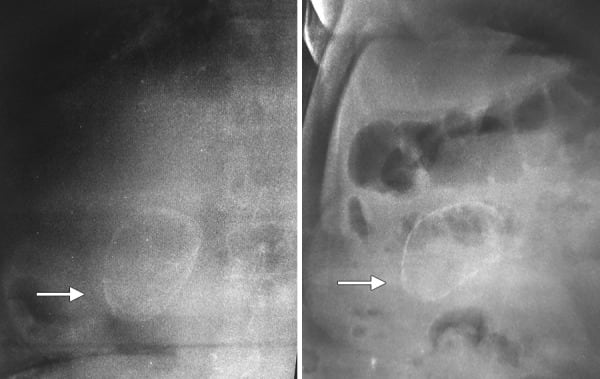
Complications of gallstones: As follows
Acute cholecystitis: It is an acute inflammation of the gallbladder caused by obstruction of the cystic duct by a gallstone. Often there is a past history of recurrent biliary colic. It presents with RUQ pain, fever, chills, RUQ mass may be palpated and a positive Murphy sign, which is inspiratory arrest on deep palpation in RUQ). Laboratory findings include leukocytosis and slightly elevated bilirubin. It can be diagnosed by ultrasound and HIDA scan if needed (failure to visualize the gallbladder in acute cholecystitis). Ultrasound shows pericholecystic fluid, gallbladder wall thickening greater than 4 mm, gallstones and sonographic Murphy sign (RUQ pain when press down the probe). Failure of HIDA or hepatobiliary iminodiacetic acid to fill the gallbladder at two hours after injection is indicative of cystic duct obstruction. Ultrasound is preferred to diagnose gallstones while HIDA scan is more sensitive and specific for acute cholecystitis. A cholecystokinin HIDA (CCK-HIDA) scan helps evaluate gallbladder contractility and can be done if clinical suspicion of gallstones or cholecystitis is high but ultrasound is negative. CCK-HIDA will also be positive in acalculous cholecystitis. CT scan and MRI can evaluate complications like empyema, gangrene etc. Treatment is with early laparoscopic cholecystectomy (within 24-72 h of symptom onset), antibiotics and supportive management. In critically ill, old patients who are bad candidates for surgery, a percutaneous cholecystostomy may help. Uncomplicated cases with no underlying conditions and ease of access to medical care can be treated on an outpatient basis with antibiotics and analgesics, given that they are afebrile and do not have common bile duct stones.
Gangrenous cholecystitis: It is necrosis and perforation of the gallbladder wall as a result of ischemia following progressive vascular insufficiency occurring as a complication of gallstones. It is seen in diabetics, old age, delayed surgery for acute cholecystitis and cardiovascular disease. It carries a very high mortality rate. Ultrasound findings include thickened gallbladder wall, pericholecystic fluid while CT shows air in the gallbladder wall or lumen, irregular or absent gallbladder wall, intraluminal membranes, pericholecystic abscess and lack of gallbladder wall enhancement. Treatment is by laparoscopic or open cholecystectomy and supportive management including antibiotics.
Emphysematous cholecystitis: It is seen in infections with Clostridia, E.coli and other gas forming organisms. It’s rapidly progressive and leads to gangrene. It is more common in old age and diabetics. Imaging shows presence of air within the gallbladder wall or lumen. Perforation of gallbladder may occur, in which case crepitus may be seen with generalised peritonitis. Clinically it presents as gangrenous cholecystitis but may be insidious. Treatment is with antibiotics, open cholecystectomy or percutaneous cholecystostomy (in some cases).
Acalculous cholecystitis: It is the inflammation of gallbladder caused by hypo or dyskinesia of gallbladder with reduced emptying, in the absence of stones. It follows long periods of fasting or starvation, TPN, rapid weight loss, critically ill ICU patients, severe burns and surgery. It has a high mortality rate as gangrene and perforation are common. Patients present with typical symptoms of acute cholecystitis plus sepsis and shock. Diagnosis is aided by CCK-HIDA scan which shows <35% gallbladder ejection fraction. Ultrasound shows a thickened gallbladder wall, pericholecystic fluid. CT and regular HIDA scan can be done. Management is with percutaneous cholecystostomy or stent via an ERCP to aid drainage of the gallbladder and antibiotics. Cholecystectomy should be done when the patient is stable.
Choledocholithiasis and ascending cholangitis: Gallstones may migrate and reach the common bile duct. Choledocholithiasis is the presence of stone in the common bile duct. This may cause obstruction and resulting infection of the bile duct called cholangitis, which presents with Charcot’s triad of fever, obstructive jaundice and abdominal pain. If it becomes severe with septicaemia then hypotension and altered mental status set in, called Reynolds pentad. It is a medical emergency and should be treated with intravenous antibiotics and ERCP to retrieve the stone. ERCP is both diagnostic and therapeutic in this condition. Ultrasound shows a dilated common bile duct. Other imaging studies that can be used are MRCP and endoscopic ultrasound, but both are not therapeutic. Laboratory findings include leukocytosis and elevated liver enzymes. Treatment is with antibiotics and ERCP with or without stenting.
Gallstone pancreatitis: The stone may migrate further down and block the opening of the pancreatic duct at the level of the Sphincter of Oddi, causing pancreatitis. Lipase and amylase are elevated. ERCP is done for diagnosis and treatment.
Gallstone ileus: It is mechanical obstruction of the intestine caused by impacted gallstones. It typically follows an episode of acute cholecystitis, with the inflammation leading to pressure and ischemic necrosis of the gallbladder wall, adhesions and formation of cholecysto-enteric fistula. The gallstone enters the intestine through the fistula and obstructs the intestine, most commonly the terminal ileum. Patients present with nausea, vomiting, crampy abdominal pain and abdominal distension. Jaundice may be present. Perforation peritonitis may occur. Imaging studies show partial or complete intestinal obstruction with dilated bowel loops and air-fluid levels; pneumobilia or contrast material in the biliary tree; an aberrant gallstone with shifting positions on serial films. Treatment is supportive and stone removal and closure of fistula. Some cases may need a bowel resection.
Sign up for free to take 4 quiz questions on this topic